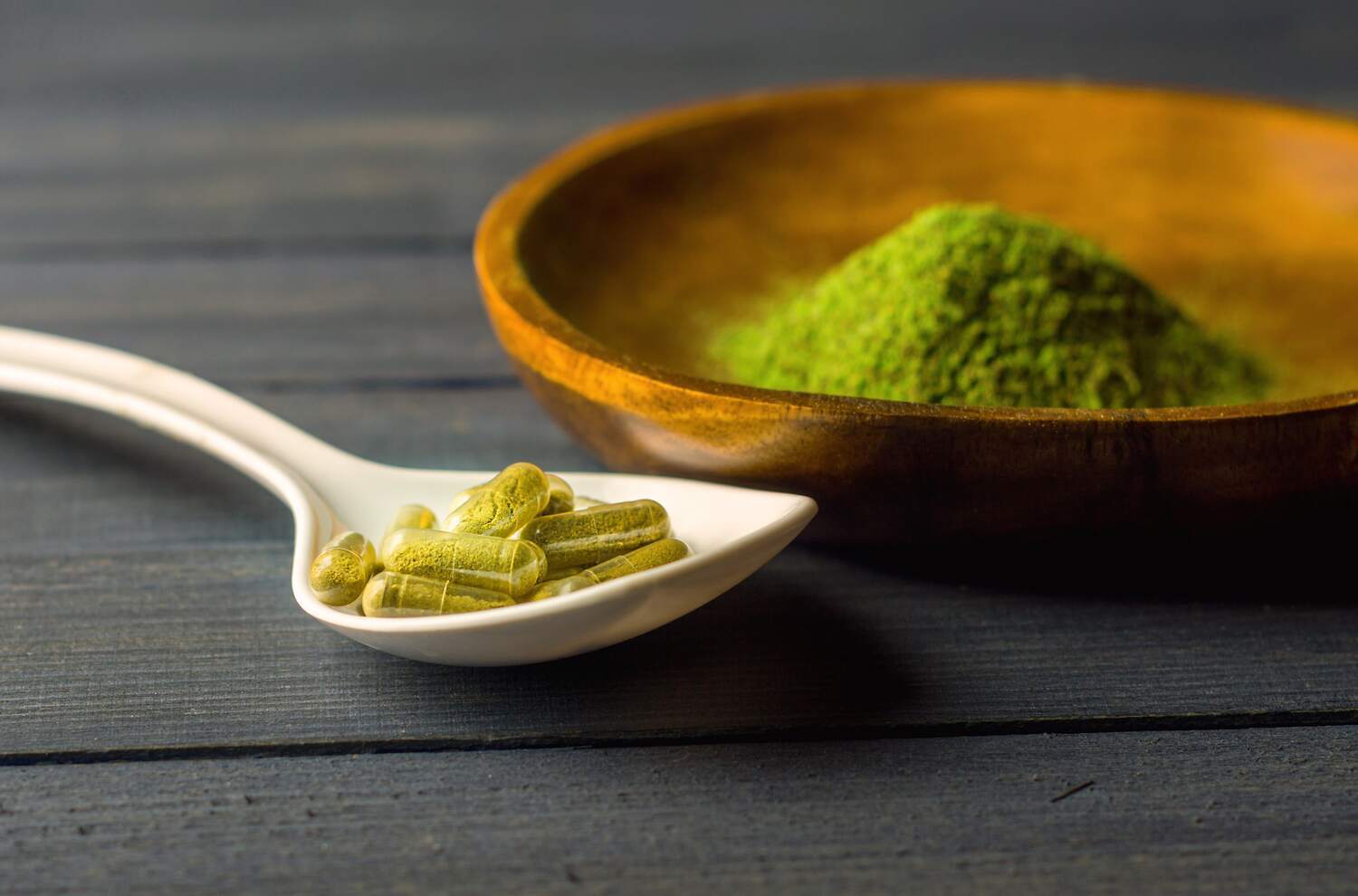You’ve probably heard of CBD, but what about kratom? This Southeast Asian herb is used as a stimulant, pain reliever, sedative, and recreational drug.
Although it’s not quite as popular as CBD, kratom use has been growing in recent years, particularly as an alternative to opioids.
As a result, many have raised the question of how kratom compares to CBD for pain relief. When should you use kratom vs. CBD? Is one better than the other? It depends on several factors.
Read on for a closer comparison of the effects and safety of these two popular herbal preparations.
What is CBD?
Cannabidiol (CBD) is one of more than 100 phytocannabinoids found in cannabis. ¹ These natural compounds are mainly responsible for the plant’s health effects.
Unlike its cousin tetrahydrocannabinol (THC), CBD is non-psychotropic, which means it can’t get you high. CBD is derived from hemp, a type of cannabis with low (0.3% or less) THC levels.
CBD has rapidly grown in popularity over the past several years. Today, millions of people use CBD oil, capsules, gummies, topicals, and other types of products to relieve anxiety, pain, insomnia, and many other health issues.
Although there’s some research evidence for these benefits, more studies are needed.
What Does CBD Do?
CBD is a fascinating compound because it can interact with so many different molecules in our bodies. So far, researchers have discovered more than 76 different targets. ²
The most prominent of these is CBD’s interaction with your endocannabinoid system (ECS). Comprised of endocannabinoids made by your body, cannabinoid receptors, and special enzymes, this system regulates from brain function to metabolism. ³
The overall role of the ECS is to maintain a healthy state of internal balance called homeostasis. CBD can support this system by reducing the breakdown of anandamide, one of the two main endocannabinoids made by our bodies. ⁴
Besides that, CBD has also been shown to interact with dozens of cell receptors, enzymes, and other molecules. This helps to explain why CBD has such a wide range of potential benefits and applications.
CBD Side Effects
According to research, CBD is an overall safe substance. While it can cause some side effects, they’re usually minor.
The most commonly reported side effects of CBD are tiredness and drowsiness, dry mouth, diarrhea and nausea, low blood pressure and lightheadedness, and changes in appetite or weight. ⁵
However, these issues were reported by studies using large oral doses of pure CBD, so they’re unlikely to occur for most CBD users.
What is Kratom?
Kratom is an evergreen tree native to Indonesia, Malaysia, Thailand, and other Southeast Asian countries. Its leaves have traditionally been used to relieve pain, increase energy levels, improve mood, and provide other benefits.
They can be chewed, brewed into a tea, smoked, or powdered to make capsules, pills, and other preparations.
More recently, kratom has been growing popular in Western countries as an alternative to prescription and illicit opioid drugs, such as morphine and heroin. Many people use it to help with addiction and withdrawal from other opioids.
This isn’t surprising as the United States and some other countries are experiencing an ongoing opioid crisis caused by the irresponsible use of opioids.
However, there’s little research on kratom’s effects, and most of what we know about it comes from user reports.
What Does Kratom Do?
Kratom is somewhat unique because it combines the effects of different types of drugs. On the one hand, kratom works similar to opioids by activating the body’s opioid receptors, resulting in pain relief, relaxation, and sedation. ⁶
On the other hand, small doses of kratom work like a stimulant, making you feel more energetic and awake.
Kratom also appears to have milder side effects, withdrawal, and a lower risk of addiction than opioids. This helps explain why so many people turn to kratom as an alternative to prescription and illegal opioids.
Kratom Side Effects
There’s little research on the safety and side effects of kratom. The most commonly reported side effects are nausea, constipation, and dizziness or drowsiness. ⁷ Less common ones include agitation, vomiting, fast heartbeat, confusion, weight loss, and dehydration.
Additionally, there have been reports of more serious issues such as seizures, hypoventilation, and hallucinations, but these are rare. ⁸
Kratom can also produce withdrawal symptoms if you stop using it after a prolonged time. These include muscle pain, insomnia, irritability, runny nose, and emotional changes. ⁹ However, users report that these effects are milder than opioid withdrawal.
Another potential risk to watch out for is kratom’s interactions with other drugs. ¹⁰
Featured Brand: Kats Botanicals
Looking to try kratom alongside CBD? Kats Botanicals is one of the few vendors to offer both products!
Redeem code 10%offsocial for 10% Off Coupon Code
Kratom vs. CBD for Pain Relief
Many people use CBD and kratom for pain, but which is better? When comparing kratom vs. CBD it’s important to consider several factors.
First and foremost, there’s safety. CBD has been examined in numerous studies, showing that it’s a relatively safe compound with minor side effects. In contrast, kratom has more potential risks and has seen little research.
The same can be said for the research evidence. There are many studies using CBD and other cannabinoids for pain relief, while only a handful of studies for kratom.
We also have to remember that there are different types of pain. This means that kratom and CBD might work better for some types but not others.
Another consideration is whether you’re already using prescription opioid painkillers.
Chronic vs. Acute Pain
CBD may be a better option for chronic pain because kratom has the potential to be addictive. If you use it for a long time, you’ll build a tolerance to kratom’s effects and may suffer withdrawal symptoms if you stop taking it.
Although reports suggest that kratom is less addictive and has milder withdrawal effects than standard opioids, it’s still a risk to keep in mind.
In contrast, CBD is completely non-addictive and may help with addiction to many drugs, including opioids. ¹¹
This makes it a safer option for dealing with ongoing pain as you don’t run the risk of becoming addicted or requiring ever-larger doses due to tolerance build-up.
On the other hand, kratom might be the better option for acute pain, such as a broken bone. Even though there’s a lack of evidence for kratom, we do know that opioids, which work similar to the main active ingredients in kratom, are effective for acute pain relief. ¹²
In comparison, there’s little research evidence backing the use of CBD for acute pain since most studies focus on chronic pain.
Nociceptive vs. Neuropathic vs. Inflammatory Pain
Another factor to consider is the type of pain. Pain can be classified into several groups based on its underlying causes:
- Nociceptive pain, which is caused by actual or imminent tissue damage, such as cuts, sprains, broken bones, and hot or cold temperatures.
- Neuropathic pain, which is caused by nerve damage or malfunction. Common causes include diabetes, multiple sclerosis, and herniated discs.
- Inflammatory pain, which involves your immune system’s inflammatory response and can also be classified as nociceptive or neuropathic, such as arthritis pain.
At this time, it’s too early to say if CBD or kratom is better for one of these types of pain. Having said that, there’s evidence that CBD and cannabinoids are effective for neuropathic and inflammatory pain. ¹³ ¹⁴
As for kratom, there are few studies. However, one human study showed that kratom increased tolerance to pain caused by exposure to cold water, which is considered nociceptive pain. ¹⁵
Additionally, animal studies suggest that kratom and its active ingredients may be effective for both nociceptive and neuropathic pain. ¹⁶ ¹⁷
Prescription Opioid Use
The third factor to consider is whether you’re already taking prescription opioid painkillers.
If that’s the case, it will likely be easier to transition to kratom because it has opioid-like effects and can lessen opioid withdrawal symptoms, especially for people who are addicted.
Still, CBD should not be underestimated. Early research suggests that CBD can reduce opioid withdrawal symptoms, so it can also help people safely transition out of using prescription opioids. ¹⁸
Besides, CBD would be safer in the long run, since it’s non-addictive and has fewer side effects.
Featured Brand: Kraken Kratom
Looking for a variety of strains to try for pain relief? Look no further than Kraken Kratom!
Combining Kratom and CBD
Another option to consider is using CBD alongside kratom. There’s some evidence that CBD can enhance the pain-relieving effects of opioids.
In one 2018 mouse study, CBD improved the effects of morphine, a common prescription opioid. ¹⁹
Similarly, a 2015 study found that the combination of CBD and morphine produced greater pain relief than morphine alone. ²⁰
However, this effect was only reported in one mouse model of pain. In the other two models, the combination treatment was less effective than morphine alone. As such, combining CBD with opioids might only be appropriate for specific types of pain.
Studies have also shown that CBD can interact with opioid receptors, which may explain how it can strengthen the effects of opioids. ²¹
Since kratom’s active ingredients also interact with opioid receptors, it might work synergistically with CBD. Nonetheless, more research is needed.
Conclusion
Both kratom and CBD show serious promise as natural pain-relievers. One is not necessarily better than the other. When comparing kratom vs. CBD it’s important to be aware of their advantages and disadvantages.
Kratom is certainly the riskier option, as it can be addictive and cause withdrawal, even if it’s milder than standard opioids. This makes kratom more suitable for acute pain.
However, it might work better than CBD for nociceptive pain. Another advantage of kratom is that it can be used to replace opioids, making it easier to manage opioid addiction and withdrawal.
Meanwhile, CBD has the advantage of safety and ample research evidence, making it more suitable for chronic pain. CBD might also work better for inflammatory pain because of its potent anti-inflammatory properties. ²²
As for neuropathic pain, studies suggest that both kratom and CBD may be effective.
The bottom line is that more research is needed to substantiate the pain-relieving benefits of kratom and CBD and figure out what types of pain they work best for.
Featured Brand: Golden Monk
If you’d like to learn more about kratom products, feel free to check out our Golden Monk review.
Redeem code GOLDENMONK10 for 10% off Golden Monk Kratom
References
1. Morales, Paula, Dow P. Hurst, and Patricia H. Reggio. “Molecular targets of the phytocannabinoids: a complex picture.” Phytocannabinoids (2017): 103-131.
2. Mlost, Jakub, Marta Bryk, and Katarzyna Starowicz. “Cannabidiol for Pain Treatment: Focus on Pharmacology and Mechanism of Action.” International journal of molecular sciences 21.22 (2020): 8870.
3. Skaper, Stephen D., and Vincenzo Di Marzo. “Endocannabinoids in nervous system health and disease: the big picture in a nutshell.” (2012): 3193-3200.
4. Leweke, F. M., et al. “Cannabidiol enhances anandamide signaling and alleviates psychotic symptoms of schizophrenia.” Translational psychiatry 2.3 (2012): e94-e94.
5. Huestis, Marilyn A., et al. “Cannabidiol adverse effects and toxicity.” Current neuropharmacology 17.10 (2019): 974-989.
6. Veltri, Charles, and Oliver Grundmann. “Current perspectives on the impact of Kratom use.” Substance abuse and rehabilitation 10 (2019): 23.
7. Grundmann, Oliver. “Patterns of kratom use and health impact in the US—results from an online survey.” Drug and alcohol dependence 176 (2017): 63-70.
8. Eggleston, William, et al. “Kratom use and toxicities in the United States.” Pharmacotherapy: The Journal of Human Pharmacology and Drug Therapy 39.7 (2019): 775-777.
9. NIDA. “Kratom DrugFacts.” National Institute on Drug Abuse, 8 Apr. 2019, https://www.drugabuse.gov/publications/drugfacts/kratom Accessed 6 Apr. 2021.
10. Tanna, Rakshit S., et al. “Refined prediction of pharmacokinetic kratom-drug interactions: time-dependent inhibition considerations.” Journal of Pharmacology and Experimental Therapeutics 376.1 (2021): 64-73.
11. Prud’homme, Mélissa, Romulus Cata, and Didier Jutras-Aswad. “Cannabidiol as an intervention for addictive behaviors: a systematic review of the evidence.” Substance abuse: research and treatment 9 (2015): SART-S25081.
12. Herzig, Shoshana J., et al. “Safe Opioid Prescribing for Acute Non-Cancer Pain in Hospitalized Adults: A Systematic Review of Existing Guidelines.” Journal of hospital medicine 13.4 (2018): 256.
13. Boychuk, Darrell G., et al. “The effectiveness of cannabinoids in the management of chronic nonmalignant neuropathic pain: a systematic review.” J Oral Facial Pain Headache 29.1 (2015): 7-14.
14. Russo, Ethan B. “Cannabinoids in the management of difficult to treat pain.” Therapeutics and clinical risk management 4.1 (2008): 245.
15. Vicknasingam, Balasingam, et al. “Focus: Plant-based Medicine and Pharmacology: Kratom and Pain Tolerance: A Randomized, Placebo-Controlled, Double-Blind Study.” The Yale Journal of Biology and Medicine 93.2 (2020): 229.
16. Chin, Kok-Yong, and Wun F. Mark-Lee. “A review on the antinociceptive effects of Mitragyna speciosa and its derivatives on animal model.” Current drug targets 19.12 (2018): 1359-1365.
17. Foss, Jeffery D., et al. “Mitragynine, bioactive alkaloid of kratom, reduces chemotherapy-induced neuropathic pain in rats through α-adrenoceptor mechanism.” Drug and alcohol dependence 209 (2020): 107946.
18. Hurd, Yasmin L., et al. “Early phase in the development of cannabidiol as a treatment for addiction: opioid relapse takes initial center stage.” Neurotherapeutics 12.4 (2015): 807-815.
19. Rodríguez-Muñoz, María, et al. “Cannabidiol enhances morphine antinociception, diminishes NMDA-mediated seizures and reduces stroke damage via the sigma 1 receptor.” Molecular brain 11.1 (2018): 1-12.
20. Neelakantan, Harshini, et al. “Distinct interactions of cannabidiol and morphine in three nociceptive behavioral models in mice.” Behavioural pharmacology 26.3 (2015): 304-314.
21. Kathmann, Markus, et al. “Cannabidiol is an allosteric modulator at mu-and delta-opioid receptors.” Naunyn-Schmiedeberg’s archives of pharmacology 372.5 (2006): 354-361.
22. Russo, Ethan B. “Cannabinoids in the management of difficult to treat pain.” Therapeutics and clinical risk management 4.1 (2008): 245.
23. Sarris, Jerome, et al. “Kava for the treatment of generalized anxiety disorder RCT: analysis of adverse reactions, liver function, addiction, and sexual effects.” Phytotherapy Research 27.11 (2013): 1723-1728.
Gleb Oleinik is a freelance CBD & cannabis writer from Vancouver, Canada. He’s read thousands of studies about cannabinoids and other beneficial natural compounds, helping him translate complex science into plain language. He’s also written third-party lab test reports of CBD products and knows the industry inside and out. When he’s not writing, Gleb likes to spend his time in the gym and out in nature.




